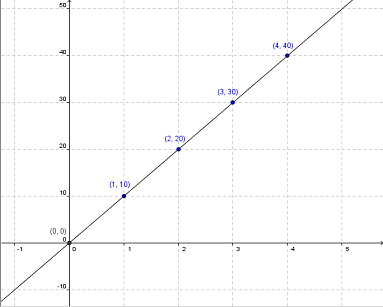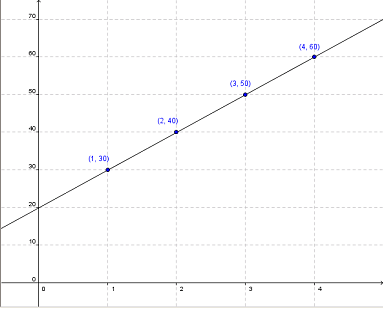Linear FunctionsObjectivesBy the end of this lesson you will be able to:
IntroductionIn the linear equation tutorial, we learned to recognize, represent and use linear relations. In this section, we will be looking at a couple of examples, but instead of linear relations, we will be looking at linear functions. In the first example, Juan has a job and earns $10 per hour.
The table and graph demonstrate the function:
Let's look at another example. Anne opened an account with the bank, deposited $20, and deposits $10 every week.
The table and graph demonstrate the function:
DefinitionThe function
is linear if when increasing the input by
1, then the output increases by a constant value.
Create Linear FunctionsExample 1:Ajay washes cars. For every car he washes, he earns 20 dollars. He has 40 dollars to start with.
Solution: We need a function that does the following:
The following table shows the values of the the function:
Here we see a linear function.
The previous table can be rewritten as f(x) equals 40 dollars plus the number of cars washed multiplied by 20 dollars.
From that table we are able to obtain: f(x)= 40 + 20x Now we can use the formula to determine how much money Ajay will have after washing 25 cars: f(25)= 40 + 20(25) = 540 Example 2:Acme Company buys a machine for $12000. The annual depreciation value of the machine is $2000.
Solution: We need a function that does the following:
The following table shows certain values of the function:
We have a linear function.
The previous table expressing f(x) can be written in the following manner:
From that table we are able to obtain the formula of the function: f(x)= 12000 - 2000x Now we can use the formula to determine when the machine will be worth $0: 0 = 12000 - 2000(x) Looking for x, we obtain x = 6. Therefore 6 years after purchase, the machine will have lost its value. Example 3:A school director analyzes student enrollment. The year the school was founded, the school started with 400 students. Since then, 50 new students have been enrolling each year.
Solution: We need a function that does the following:
The following table shows certain values of the function:
Here we have a linear function:
The previous table expressing f(x) may be rewritten in the following manner
From that table, it is possible to obtain the formula of the function: f(x)= 400 + 50x Now we are able to use the formula to determine how many students there will be after 15 years: f(15) = 400 + 50(15) = 1150 The school will have 1150 students after 15 years. SummaryNow that you have completed the section you are able to:
|









